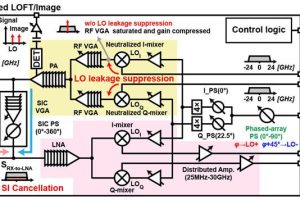
It involves exploiting a rotational form of the Doppler effect, and researchers from University of Shanghai for Science and Technology (USST) have managed to get the technique working at terahertz (THz) frequencies.
“To the best of our knowledge, this study represents the first demonstration of an integrated THz vortex beam emitter specifically designed for the detection of rotating targets,” said USST professor Yiming Zhu.
The emitter is made on a high-resistance silicon wafer and is a ring driven by a passing coupled waveguide (see diagram) – similar to whispering gallery mode resonator-emitter.
Surface features etched into the top of the ring resonator suppress one of the circular polarisations to create a single circularly-polarised vortex beam instead of the vector vortex beam with cylindrically symmetric polarisation states that would be emitted by a plain ring.
With the single-polarised beam, rotational Doppler-modified reflections can be received using a linearly polarised antenna, which could not usefully receive returns with symmetric states.
The scheme above on its own would be strongly affected by microscopic vibrations and movements in the rotating targets, which would create spurious frequencies in the received signal.
To counter this, two different resonances are excited in the ring to create two beams with ±1 ‘topological charges’, said the university, allowing signals due to microscopic movement to be effectively distinguished.
 Measurement results of speed between 251 and 628rad/s. Red points are measured data, blue line is theoretical and δ is the absolute error
Measurement results of speed between 251 and 628rad/s. Red points are measured data, blue line is theoretical and δ is the absolute error
“This offers a way to pinpoint an object’s rotational speed with remarkable precision,” said the university. “Through identification and detection of the rotational Doppler effect within the frequency spectrum, the rotational speed of the object can be quantified with a maximum margin of error of around 2%.”
The work is covered in full in ‘Integrated terahertz vortex beam emitter for rotating target detection‘, published in the journal Advanced Photonics – full paper available without payment.
Images: Jingya Xie USST
 Electronics Weekly Electronics Design & Components Tech News
Electronics Weekly Electronics Design & Components Tech News



